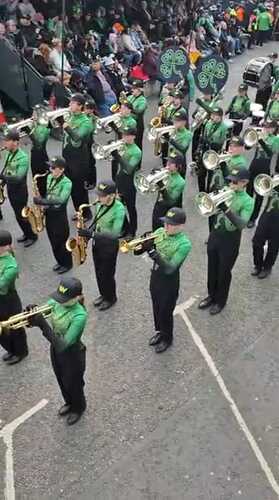Today is St Patrick Day in Ireland
So gocity didnt have a english version but fun facts behind it >german to English translated 
Learn more about the iconic saint behind the Irish National Day in this article. We have some of the few known information in 10 facts about St. Patrick - St Patrick’s Day Ireland put together for you.
The next St. Patrick’s Day in Ireland is coming and we thought we were taking a look at the history books to find out more about the Irish patron saint. While his name day is celebrated all over the country with parties and parades, the question arises: What do we actually know about the man himself? Find out here our 10 favorite facts about St. Patrick that you may not have known yet!
1. St. Patrick was actually not an Irishman
Although he is the patron saint of Ireland, Saint Patrick was born in the UK, either in Scotland or in Wales (the data vary). His parents, Calpurnius and Conchessa, were both Roman citizens, and his mother gave birth to him in AD 385.
2nd Slavery brought St. Patrick to Ireland
As a teenager, St. Patrick was kidnapped by a pirate attack and sold to slavery in Ireland. As a slave, he looked after sheep for many years before fleeing to a monastery in England. There he was ordained a devout follower of Christianity and a bishop, whereupon he returned to Ireland as a missionary.
3rd The shamrock as an Irish symbol is said to have been popularized by St. Patrick
According to legend, Saint Patrick used the iconic cloverleaf to explain the Holy Trinity in his sermon. The three leaves therefore represent the Holy Father, the Son and the Holy Spirit of Christianity. For St. Patrick, the cloverleaf was a symbol that showed that each of the three different spiritual entities can be and yet all are part of the same whole.
4th St. Patrick was actually wearing blue clothes - and not green ones
Although it is a tradition to wear green on St. Patrick’s Day, all preserved works of art show St. Patrick in a blue guise. This is the reason why flags, sports uniforms and coats of arms have been kept in this color over the years. Over time, the color green became more and more popular as a national color, especially in the 17th Century.
5. St. Patrick probably didn’t drive snakes out of Ireland
One of the most popular myths about the Irish saint is that he has freed the country from snakes, but modern science has now annulled this belief. Since Ireland has always been an incredibly cold country, scientists believe that there have been snakes at all - and there are no fossils that could disprove this theory.
6. Patrick was not the first name of St. Patrick
St. Patrick’s first name was Maewyn Succat . It was only when he became a priest that he adopted a new name - Patrick, after Patricius (which relates to the Latin origin of father relates).
7. St Patrick’s Day Ireland is celebrated on the day St. Patrick died
In the Catholic tradition, the day a saint dies is considered a holy day when his ascension to heaven is celebrated. Saint Patrick died on the 17th March and on this day, St. Patrick’s Day is still celebrated annually.
8th. St. Patrick is actually not a saint
Although he has this title in the vernacular, St. Patrick was never officially recognized as a saint. Nevertheless, many recognize his merits for the Catholic Church and he remains a spiritual figure to this day.
9. The “drowning of the cloverleaf” is said to have started with St. Patrick
The tradition of drinking to celebrate St. Patrick’s Day should go back to the saint himself, who came up with the idea that diving the cloverleaf into a glass of whiskey should bring happiness to the drinker. There was a short time when drinking on St. Patrick’s Day was prohibited, but since then the tradition has come into full force.
10. St. Patrick’s walking stick supposedly grew into a tree while preaching
Another popular legend about St. Patrick tells how he left his ash-wood walking stick in the ground when he left to convert the inhabitants of a small town to Christianity. However, the efforts continued so long that an ash tree grew out of the walking stick, after which the city of Aspatria (in Cumbria) is named.
![]()
![]() double 73%
double 73% ![]()










